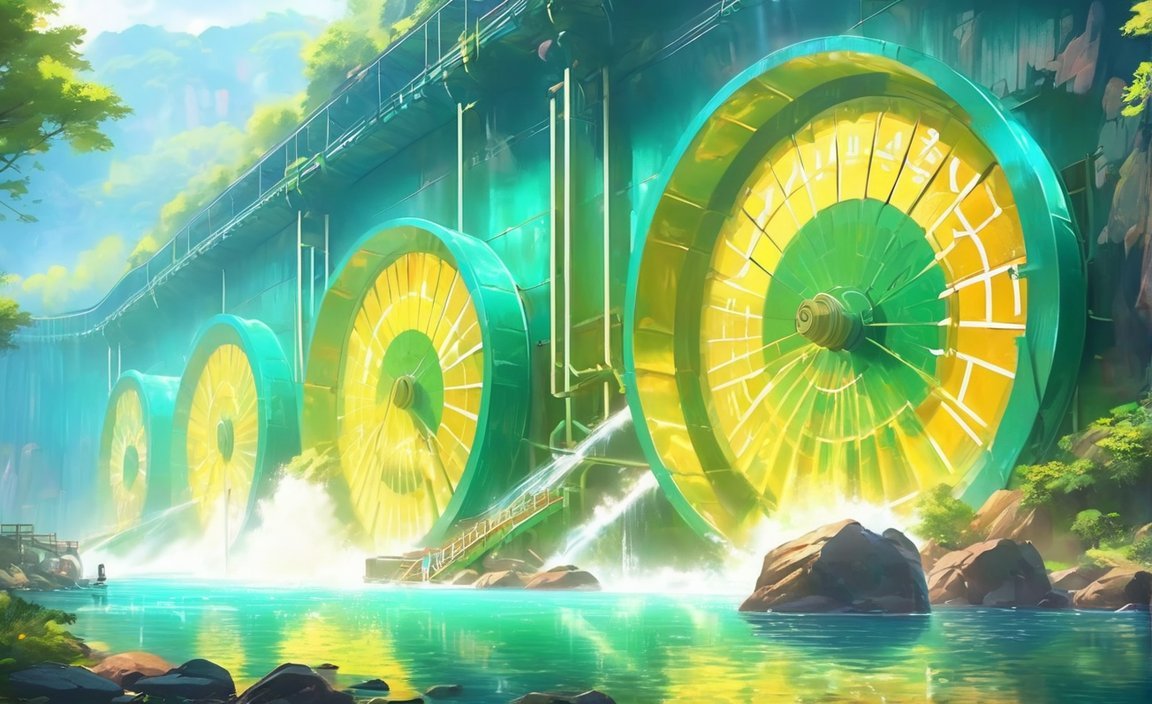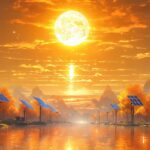Discover 5 Fascinating Hydroelectric Energy Facts: Hydroelectric energy is a captivating field that offers a multitude of intriguing facts. From its ability to generate sustainable power to its impact on the environment and local communities, hydroelectric energy is a topic that deserves attention. In this article, we will explore five interesting facts about hydroelectric energy that will leave you enlightened and inspired. So, let’s dive into the world of hydroelectric power generation and discover the remarkable aspects it holds.

Key Takeaways:
- Water is a plentiful, free, and renewable source of energy for hydroelectric power.
- Hydroelectric power generation does not produce carbon dioxide emissions.
- Electricity can be generated 24 hours a day with a consistent water supply.
- The United States has over 2,000 hydroelectric power plants.
- Countries like Norway and Brazil rely on hydropower for a significant portion of their electricity needs.
- The Three Gorges Dam in China is the largest dam and hydroelectric power plant in the world.
- Hydroelectricity is a cost-effective energy source.
- Hydroelectric dams use fish ladders and elevators for fish migration.
- Hydropower is one of the cleanest and most efficient sources of energy.
- The Niagara Falls dam was the first dam in America.
- Dams for hydroelectric power generation can vary in design and efficiency.
5 Interesting Facts about Hydroelectric Energy
Water is a powerful resource that holds incredible potential. Have you ever wondered how it can be harnessed to generate electricity? Hydroelectric energy is the answer! Here are 5 fascinating facts about hydroelectric energy that will leave you amazed at the wonders of renewable power.
Fact 1: Plentiful Water, Limitless Energy
Did you know that water is not only abundant but also free and renewable? Unlike fossil fuels, which have limited reserves, water can be found in lakes, rivers, and oceans all around the world, making it a never-ending source of energy. It’s nature’s gift that keeps on giving!
Fact 2: Mother Nature’s Carbon-Free Power
In our race to combat climate change, hydroelectric power stands out as a superhero. By harnessing the force of flowing water, hydroelectric power doesn’t produce any carbon dioxide emissions. So not only does it create electricity, but it also helps protect our environment from harmful greenhouse gases.
Fact 3: A Round-the-Clock Power Supply
Imagine having access to electricity anytime you need it. With hydroelectric power, it’s possible! As long as there’s enough water, electricity can be generated 24 hours a day. Unlike solar or wind energy, which depend on weather conditions, hydroelectric power provides a consistent and reliable power supply.
Fact 4: Hydroelectric Power around the World
Hydroelectric power plants can be found all over the globe, but did you know that the United States alone has over 2,000 hydroelectric power plants? That’s a staggering number! But it’s not just the United States. Many countries, like Norway and Brazil, heavily rely on hydropower for their electricity needs, with some getting as much as 85% of their power from this clean energy source.
Fact 5: The Mighty Three Gorges Dam
Prepare to be awestruck by the largest dam and hydroelectric power plant in the world—the Three Gorges Dam in China. This engineering marvel spans the Yangtze River and provides an astonishing amount of power. It’s a testament to the immense capabilities of hydroelectric power generation.
Now that you’ve learned these fantastic facts about hydroelectric energy, it’s clear why it’s such an essential part of our sustainable future. From its cost-effectiveness to its clean and efficient nature, hydropower is a true force to be reckoned with. So next time you flip a switch and the lights come on, remember the remarkable journey of water transforming into energy!
Do you know the 5 fun facts about hydro energy? Find out more about it here.
Looking for ways to conserve water in agriculture? Check out these 5 methods of water conservation here.
Water is essential for plants, but do you know the 5 importance of water to plants? Discover more here.
Rivers are not just bodies of water, they play a crucial role in our ecosystem. Learn more about the 5 reasons why rivers are important here.
Outline 3: The Environmental Impact and Sustainability of Hydroelectric Energy
Key Takeaways:
- Hydroelectric power has significant environmental impacts, including damage to wildlife habitats and interference with natural river systems.
- The construction of hydropower plants can alter land use and have lasting effects on rivers and surrounding areas.
- Reservoirs created by hydroelectric power plants emit greenhouse gases, contributing to climate change.
- The sustainability of hydropower plants depends on various factors, such as size, time, and site qualities, and consideration of ecological and societal implications.
- Advancements in technology and research can help mitigate the environmental impacts of hydroelectric power and pave the way for a clean energy future.
Hydroelectric energy is often hailed as a sustainable and renewable source of power. However, like any form of energy generation, it comes with its unique environmental impacts. Understanding these impacts and ensuring the sustainability of hydroelectric power is crucial for a cleaner and greener future.
Environmental Impacts of Hydroelectric Power
1. Damage to Wildlife Habitats and Migratory Paths
Building dams for hydropower projects can disrupt the natural flow of rivers and negatively affect the habitats and migratory patterns of aquatic species. Fish, in particular, rely on unobstructed river systems for spawning and migration. Blocking or diverting rivers can lead to declines in fish populations and harm overall ecosystem balance.
2. Land Use
The construction of large storage or pumped storage hydropower plants requires extensive land use. Rivers and the areas surrounding them may undergo significant alterations to accommodate these projects. This can result in the loss of natural landscapes, biodiversity, and cultural heritage, affecting both humans and wildlife.
3. Greenhouse Gas Emissions from Reservoirs
While hydroelectric power is considered a clean energy source in terms of direct emissions, it is not entirely free from environmental impacts. The creation of reservoirs behind dams can lead to the decomposition of organic matter, which releases greenhouse gases such as carbon dioxide and methane. These emissions contribute to climate change and must be taken into account when assessing the overall environmental impact of hydroelectric power.
Sustainability of Hydroelectric Power
1. Factors Affecting the Sustainability of Hydropower Plants
The sustainability of hydropower plants depends on various factors, including their size, the length of time they operate, and the qualities of their sites. Smaller-scale hydropower plants and those with shorter lifespans tend to have lower environmental impacts. Additionally, considering ecological and societal implications is vital for ensuring the long-term sustainability of hydropower projects.
2. Future of Hydroelectric Power
Despite the environmental impacts associated with hydropower, it continues to play a significant role in renewable energy generation. Increasing the capacity of existing dams and embracing new run-of-the-river projects can help meet the growing demand for electricity while minimizing ecological disturbances. Advancements in technology, such as fish-friendly turbines and improved fish passage systems, can further reduce the negative impacts of hydropower on aquatic ecosystems.
Case Studies and Research on Hydroelectric Power
- A comprehensive study titled “The potential for sustainable hydropower” published in Nature delves into the potential for more sustainable hydropower generation.
- The article “Hydropower and environmental sustainability: A holistic approach” available on ScienceDirect explores the importance of adopting a holistic approach to minimize the environmental impacts of hydroelectric power.
By understanding the environmental impacts and working towards sustainable practices, the potential of hydroelectric power can be maximized without endangering ecosystems or contributing significantly to climate change.
Sources:
1. Union of Concerned Scientists. (n.d.). Environmental Impacts of Hydroelectric Power. Retrieved from UCSUSA
2. EnergySage. (n.d.). The Environmental Impacts of Hydropower. Retrieved from EnergySage
Outline 4: Significant Hydroelectric Power Projects Around the World
Hydropower is a vital source of renewable energy and plays a crucial role in combating climate change. To further explore this fascinating energy source, let’s delve into some significant hydroelectric power projects around the world.
Key Takeaways:
- Hydropower is currently the largest source of renewable energy worldwide, generating more electricity than all other renewable technologies combined.
- The International Renewable Energy Agency (IRENA) highlights the need for a 60% increase in the world’s existing hydropower capacity by 2050 to limit global temperature rise to below two degrees Celsius.
- The International Energy Agency (IEA) states that an additional 1,300 GW of hydropower capacity is required to meet future energy demands.
- China, Brazil, Canada, the U.S., and Russia are the leading producers of hydropower.
Hydroelectric power projects are prominent across the globe, showcasing the immense potential and benefits of this clean energy source. Let’s explore four significant projects:
1. Three Gorges Dam, China
- Located on the Yangtze River, the Three Gorges Dam is the world’s largest hydroelectric power station, generating an astounding 22,500 megawatts of electricity.
- This impressive project spans over two miles and has the capacity to provide clean energy to millions of people.
- In addition to electricity generation, the Three Gorges Dam also offers flood control, improving the safety and security of communities along the Yangtze River.
2. Itaipu Dam, Brazil and Paraguay
- The Itaipu Dam, situated on the Paraná River between Brazil and Paraguay, stands as one of the largest hydroelectric power plants in the world.
- With a capacity of 14,000 megawatts, Itaipu Dam produces an astounding amount of renewable energy that caters to the needs of both countries.
- This project not only provides substantial electricity to the region but also supports the sustainability efforts of Brazil and Paraguay.
3. Grand Coulee Dam, United States
- Located in the state of Washington, the Grand Coulee Dam is the largest hydropower project in the United States.
- This iconic dam generates approximately 6,809 megawatts of electricity, making it a crucial contributor to the country’s clean energy mix.
- Furthermore, the Grand Coulee Dam plays a vital role in irrigating vast agricultural lands, supporting the region’s agriculture industry.
4. Sayano-Shushenskaya Dam, Russia
- Situated on the Yenisei River in Russia, the Sayano-Shushenskaya Dam is known for its impressive capacity of 6,400 megawatts.
- Despite a tragic accident in 2009, this project remains a significant contributor to Russia’s energy production.
- The Sayano-Shushenskaya Dam harnesses the power of the Yenisei River, providing reliable and clean electricity to both industrial and residential areas.
These remarkable hydroelectric power projects demonstrate the immense potential for global energy production and the substantial benefits of harnessing clean, renewable sources of power. By further investing in and expanding these projects, we can pave the way for a sustainable and greener future.
Citations:
– National Geographic. “Hydropower facts and information.” Link
– International Hydropower Association. “Facts about Hydropower.” Link
Outline 5: The future prospects and advancements in hydroelectric energy technology
The future of hydroelectric energy holds exciting prospects for advancements in technology and sustainability. With a focus on innovation and efficiency, the industry aims to overcome challenges and contribute to a cleaner and greener future. Here are some key insights into the future prospects and advancements in hydroelectric energy technology:
1. The Quest for Increased Hydropower Capacity
As the largest source of renewable energy worldwide, hydropower plays a pivotal role in reducing carbon emissions and meeting growing energy demands. According to the International Renewable Energy Agency (IRENA), there is a pressing need for a 60% increase in global hydropower capacity by 2050 to limit the rise in global temperatures. The International Energy Agency (IEA) also emphasizes the requirement for an additional 1,300 GW of hydropower capacity to address future energy needs. These efforts reflect a shared commitment to harnessing the potential of hydroelectricity.
2. Advancements in Digitalization and the Industrial Internet of Things (IIoT)
In the pursuit of enhanced operations and increased efficiency, the hydropower industry is looking towards the Industrial Internet of Things (IIoT) and digitalization. By integrating advanced sensors, real-time data collection, and predictive analytics, hydropower plants can optimize performance, monitor equipment health, and react promptly to any potential issues. These technological advancements not only streamline operations but also contribute to the longevity and sustainability of hydropower projects.
3. Moving Beyond Large-Scale Dams and Environmental Impacts
While conventional hydropower projects often involve large-scale dams, the industry is exploring alternatives that minimize environmental damage and social displacement. The development of hydropower plants without dams presents a promising solution. By utilizing innovative technologies, such as run-of-river, in-stream, and underground facilities, the adverse impacts on ecosystems and communities can be significantly reduced. These advancements pave the way for a more sustainable and inclusive approach to hydropower generation.
4. Increasing Flexibility, Efficiency, and Cost-Effectiveness
Emerging technological trends aim to enhance the flexibility, efficiency, and cost-effectiveness of hydropower systems. Advances in turbine design and optimization techniques contribute to improved energy conversion and reduced operational costs. Additionally, the integration of energy storage solutions, such as pumped storage hydroelectricity, enables better utilization of intermittent renewable energy sources and enhances grid stability. These technological advancements position hydropower as a reliable and adaptable contributor to clean energy transitions.
5. Marine Energy and the Quest for 100% Clean Energy Future
Beyond conventional hydroelectric power, research and investments are being directed towards marine energy. Institutions like the National Renewable Energy Laboratory (NREL) are working to advance marine energy technologies and maximize the potential of hydropower from tides, waves, and ocean currents. By embracing marine energy alongside traditional hydropower, the industry can move closer to achieving a 100% clean energy future.
Key Takeaways:
- The hydropower industry aims to increase global hydropower capacity by 60% by 2050 to address climate change and meet growing energy needs.
- Digitalization and the Industrial Internet of Things (IIoT) offer opportunities for improved operations and efficiency in hydropower plants.
- Hydropower projects without dams minimize environmental damage and social displacement, promoting sustainability and inclusivity.
- Technological advancements focus on increasing the flexibility, efficiency, and cost-effectiveness of hydropower systems.
- Research and investments in marine energy contribute to the exploration of diverse hydropower sources for a cleaner energy future.
Citations:
1. IRENA: “Hydropower”
2. IEA: “The Future of Hydropower”

FAQ
Q1: How does hydroelectric energy impact the environment?
A1: Hydroelectric energy can have both positive and negative environmental impacts. While it is a renewable source of energy and does not produce carbon dioxide emissions, it can damage wildlife habitats and disrupt fish migration routes. Additionally, the creation of reservoirs for hydroelectric power plants can emit greenhouse gases through the decomposition of organic matter.
Q2: Is hydroelectric power sustainable?
A2: The sustainability of hydroelectric power depends on various factors. The size, time, and site qualities of hydropower plants play a vital role in their long-term sustainability. It is important to consider the ecological and societal implications of hydroelectric projects to ensure their sustainability. Advancements in technology and careful planning can help mitigate the environmental impacts associated with hydropower.
Q3: How much electricity is generated from hydroelectric power globally?
A3: Hydroelectric power is currently the largest source of renewable energy worldwide and generates more electricity than all other renewable technologies combined. It plays a significant role in meeting global energy demands and combating climate change.
Q4: Which countries are leading producers of hydroelectric power?
A4: China, Brazil, Canada, the United States, and Russia are the leading producers of hydroelectric power. These countries have extensive water resources and robust infrastructure for hydropower generation.
Q5: What are the environmental and societal controversies surrounding hydroelectric power?
A5: The development of hydroelectric power is controversial due to its potential environmental and societal impacts. Hydropower projects can cause significant damage to ecosystems, wildlife habitats, and indigenous communities. Additionally, the displacement of local populations and changes to river systems can have far-reaching social consequences. Efforts are being made to minimize these negative impacts and explore alternative forms of hydropower that do not require large-scale dams.















